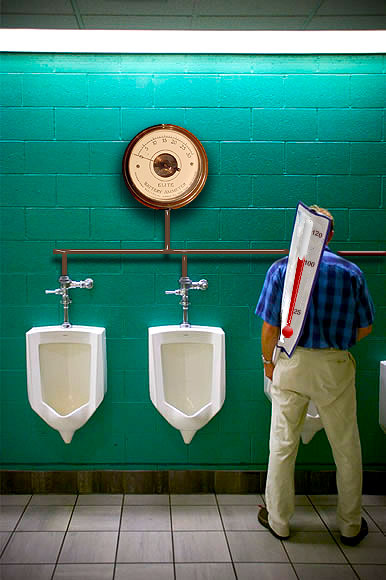Green heat is where you find it
Norwegians, ever inventive folks, have introduced a way to heat their homes and offices as they flush their toilets.

By employing a simple heat transfer system that uses refrigeration techniques the Norwegian company Viken Fjernvarme, Oslo Energy Company, is able to collect heat from Oslo’s sewage system and transfer it to a system of clean water pipes, which feed thousands of radiators and hot water taps throughout the city.
The pipes are built into a 300-meter long tunnel in central Oslo. Here they collect heat from the warmer sewage system and transfer it to pipes that serve the main steam heat distribution network. The typical heat differential between the sewage pipe system and the hot water system is almost 4 º Celsius or just over 39 º.
"We believe this is the biggest heating system in the world using raw sewage," Says Lars-Anders Loervik, managing director of Viken Fjernvarme.
The pump uses a system of compressors and condensers to generate 18 megawatts, enough heat energy to warm 9,000 flats or save 6,000 tons of oil a year, he says. The energy turned to heat is further augmented by local industrial waste incineration plants.
They also retrieve heat from the electricity used to drive the system’s pumps and condensers. About one-third of the calories come from this source and two-thirds from the untreated sewage waste of toilets, bathtubs, showers, sinks and just plain rainwater runoff. The wastewater goes into the system at 9.6 º Celsius and comes out at 5.7 º.
Dr Monica Axell, head of the International Energy Agency's heat pump centre, says the concept could be a feasible solution for many cities as long as they have the necessary infrastructure.
Reportedly, there are some problems however, that even masterful engineering cannot solve; the system has peak efficiency and then, at other times, vexingly low levels of heat collection. According to one plant employee, “When people have been out to parties there’s a lot of beer going into the sewer,” he says.

by Harlan Weikle
Greener Magazine

By employing a simple heat transfer system that uses refrigeration techniques the Norwegian company Viken Fjernvarme, Oslo Energy Company, is able to collect heat from Oslo’s sewage system and transfer it to a system of clean water pipes, which feed thousands of radiators and hot water taps throughout the city.
The pipes are built into a 300-meter long tunnel in central Oslo. Here they collect heat from the warmer sewage system and transfer it to pipes that serve the main steam heat distribution network. The typical heat differential between the sewage pipe system and the hot water system is almost 4 º Celsius or just over 39 º.

"We believe this is the biggest heating system in the world using raw sewage," Says Lars-Anders Loervik, managing director of Viken Fjernvarme.
The pump uses a system of compressors and condensers to generate 18 megawatts, enough heat energy to warm 9,000 flats or save 6,000 tons of oil a year, he says. The energy turned to heat is further augmented by local industrial waste incineration plants.
They also retrieve heat from the electricity used to drive the system’s pumps and condensers. About one-third of the calories come from this source and two-thirds from the untreated sewage waste of toilets, bathtubs, showers, sinks and just plain rainwater runoff. The wastewater goes into the system at 9.6 º Celsius and comes out at 5.7 º.
Dr Monica Axell, head of the International Energy Agency's heat pump centre, says the concept could be a feasible solution for many cities as long as they have the necessary infrastructure.
Reportedly, there are some problems however, that even masterful engineering cannot solve; the system has peak efficiency and then, at other times, vexingly low levels of heat collection. According to one plant employee, “When people have been out to parties there’s a lot of beer going into the sewer,” he says.

by Harlan Weikle
Greener Magazine



3:31 PM









<< Home